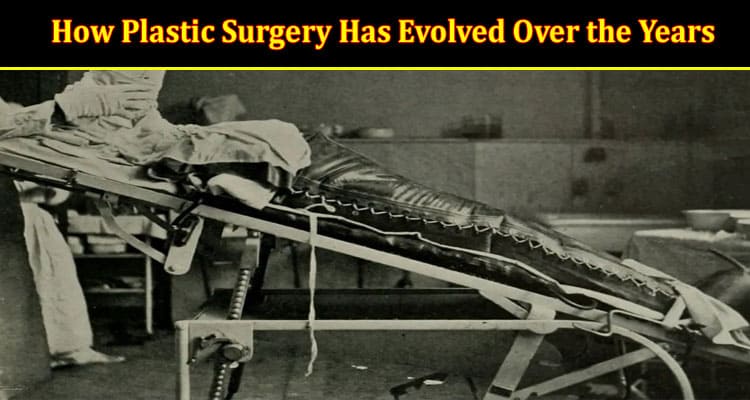Plastic surgery has supported human beings in their quest for constant self-improvement for centuries. This medical specialty has been around since ancient times and has experienced tremendous growth since then. Here’s an overview of the evolution of plastic surgery:
Plastic Surgery in Ancient Civilizations
Researchers have traced the origins of plastic surgery to ancient civilizations in India, Egypt, Rome, and China. Reconstructive surgery can be dated back to the 6th century BC in India. Indian physicians used skin grafts to reconstruct noses that had been amputated as a form of punishment at the time. This is one of the first records of rhinoplasty. Egyptian physicians also performed rhinoplasty to repair broken noses.
Blepharoplasty, a procedure performed to remove excess skin around the eyes, can be traced back to ancient Rome. The procedure was performed on patients who had trouble seeing because of the excess skin. Chinese doctors are believed to have performed the first cleft lip repair surgery. This surgery can be traced back to the 4th century.
Surgical procedures in the early days were rudimentary. Wine and other forms of alcohol were commonly used as anesthetics and wound cleaners before surgery. Due to the level of risk and amount of pain involved, plastic surgery was, at the time, reserved for patients who needed it. It was performed to improve patients’ quality of life, not for aesthetic purposes.
The World Wars and Reconstructive Surgery
The World Wars contributed heavily to advancements in reconstructive surgery, as many soldiers had major face and limb injuries. The high number of patients at this time allowed surgeons to refine their surgical processes and techniques. Surgeons who once used paraffin wax to recontour patients’ faces began to move away from this technique as they realized the wax would melt when exposed to high temperatures. Skin grafts became a popular alternative to prosthetics for facial reconstructions. The war period also saw surgeons perform skin grafts on other regions of the body to treat burn victims. This sparked the idea that plastic surgery could be used for more than reconstructive purposes.
Post-war Aesthetic Surgery
The post-war period saw high demand for cosmetic enhancements. Aesthetic surgery emerged as a branch of plastic surgery, mainly focusing on improving physical appearance. This propelled the introduction of procedures like liposuction and breast augmentation. During the 1960s and 1970s, botulinum toxin injections were used to treat facial and ocular misalignments. These injections were later adopted as less invasive plastic surgery procedures. The popularity of aesthetic surgeries was partially fueled by the rise of popular film and media during this period. Procedures now also had a reduced risk of complications as surgeons had a deeper understanding of aseptic techniques. The use of general and local anesthesia also helped diminish the pain of these surgeries and procedures.
Evolution of Surgical Procedures
Breast augmentation has evolved significantly since its introduction. In the early days, some surgeons injected silicone directly into women’s breasts to make them appear fuller. They later shifted to safer options like saline implants and cohesive gel implants. Cohesive gel implants became popular as they retain their shape better than saline implants. Autologous breast augmentation has also become a popular option. This procedure involves using one’s own tissue instead of implants to achieve fuller breasts.
Early liposuction procedures have evolved from surgeons using a suction-assisted method to remove fat cells from the body. This method involved injecting fluid into body tissues to break up fat cells and removing them with a suction device. Today, surgeons use safer and more precise techniques like laser-assisted liposuction and ultrasound-assisted liposuction. These techniques involve using a laser or ultrasound to liquefy fat before removal.
The pursuit of facial rejuvenation has also fuelled innovations in plastic surgery. Facelifts have evolved from invasive procedures with long recovery periods to minimally-invasive procedures with relatively short recovery times. Injectables like dermal fillers and Botox have become popular among patients looking for easy and effective facial rejuvenation procedures. The injectables can help reduce the appearance of wrinkles and restore volume, giving patients a more youthful look.
Modern Developments
Surgeons today use modern technology to streamline procedures and improve patient satisfaction. Some use three-dimensional imaging systems to visualize results before beginning a procedure. This facilitates better communication between doctors and patients, as both parties better understand what to expect from procedures. Some surgeons have also adopted laser technology in their plastic surgery procedures. Laser surgery results in minimal bruising, bleeding, and scarring for patients.
Regenerative medicine has the potential to revolutionize plastic surgery. Stem cell therapy promotes scarless wound healing by using stem cells’ regenerative properties to repair damaged tissue. Fat grafting and platelet-rich plasma therapy are emerging technologies that can improve surgery outcomes. Fat grafting involves transferring fat cells from one body part to other areas where patients want additional volume. Platelet-rich plasma therapy involves extracting platelets and growth factors from a patient’s blood and injecting them into the target area to facilitate tissue regeneration.
Plastic Surgery Continues to Evolve
Plastic surgery continues to evolve from its ancient origins as researchers seek more effective and safer techniques to achieve successful results. Over the years, surgeons have shifted from invasive to minimally invasive techniques to enhance patients’ comfort and reduce recovery periods. This branch of surgery will continue evolving alongside modern technological and medical advancements.

